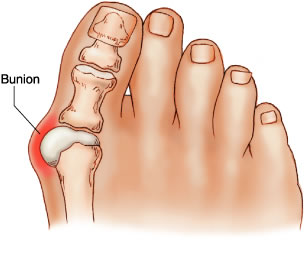Hallux Valgus
Hallux valgus, also known as a bunion, is a common foot deformity characterized by a bony
bump that forms on the joint at the base of the big toe. This bump is actually a misaligned
toe bone that has shifted towards the second toe, causing the joint to become inflamed
and painful.
Causes of Hallux Valgus
- Genetics: Family history can play a role in the development of hallux valgus.
- Foot mechanics: Abnormalities in the way the foot functions, such as overpronation or
flat feet, can contribute to the development of hallux valgus. - Poorly fitting shoes: Wearing shoes that are too tight or don’t fit properly can put pressure
on the toe joint, leading to hallux valgus. - Aging: Hallux valgus can develop over time due to wear and tear on the joints.
- Arthritis: Certain types of arthritis, such as rheumatoid arthritis, can increase the risk of
developing hallux valgus.
Symptoms of Hallux Valgus
- Pain: Pain or tenderness in the big toe joint or surrounding area.
- Redness and swelling: Inflammation and swelling around the big toe joint.
- Bony bump: A visible bump on the joint at the base of the big toe.
- Limited mobility: Difficulty moving the big toe or walking due to pain or stiffness.
Treatment Options for Hallux Valgus
- Conservative treatments: Padding, taping, or splinting the foot to reduce pressure and
alleviate pain. - Orthotics: Custom-made shoe inserts or orthotics to redistribute pressure and alleviate
pain. - Physical therapy: Exercises and stretches to improve foot mechanics and reduce pain.
- Surgery: In severe cases, surgery may be necessary to realign the toe bone and relieve
pressure.
Ozone Therapy for Hallux Valgus
Ozone therapy has been explored as a potential treatment for hallux valgus, with some
studies suggesting benefits such as:
- Reduced pain and inflammation: Ozone therapy may help reduce pain and inflammation
in the affected joint. - Improved joint mobility: Ozone therapy may help improve joint mobility and reduce
stiffness. - Enhanced wound healing: Ozone therapy may help promote wound healing and tissue
repair.
However, more research is needed to fully understand the effects of ozone therapy in
treating hallux valgus.

